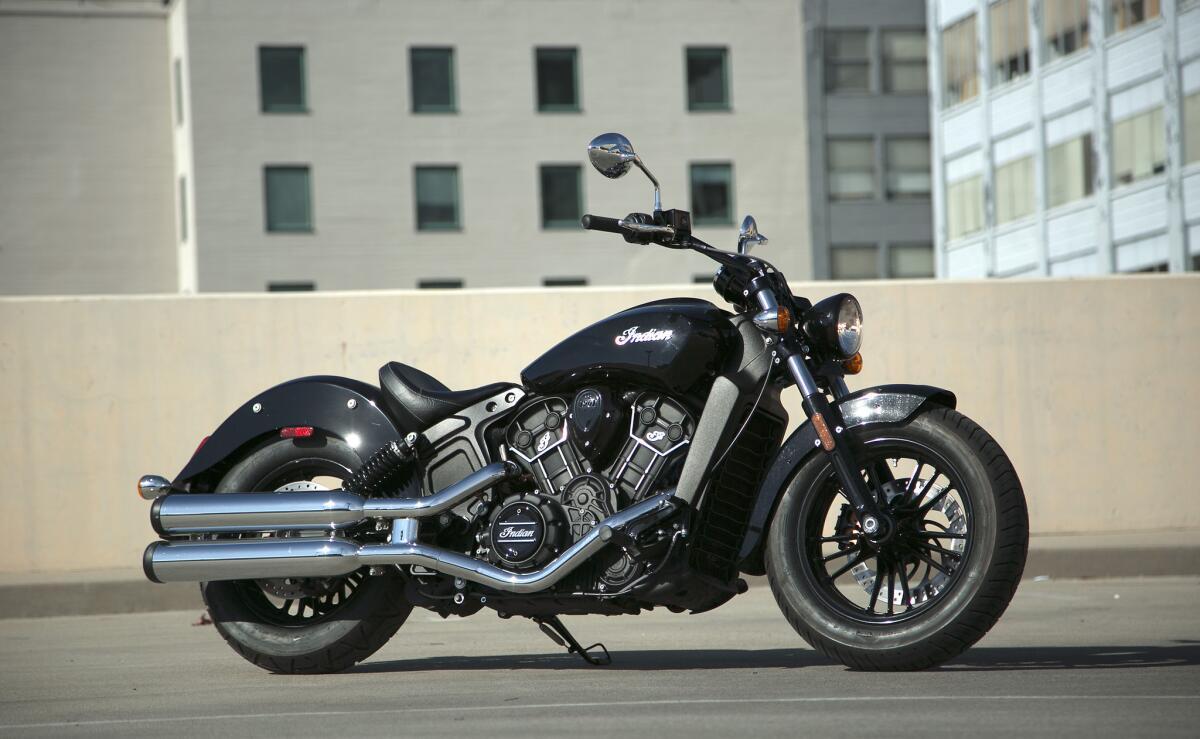Indian Scout Sixty: An American 999-cc ‘starter bike’

Indian Motorcycle has added a smaller version of its popular Scout -- the Scout Sixty, taking direct aim at Harley-Davidson’s Iron 883s and trying to lure newer riders to the sport.
- Share via
Indian Motorcycle is going down -- in size, scale and price.
The company has introduced a smaller version of its popular Scout, the 1200-cc lightweight retro-styled cruiser that hit the market 18 months ago as a 2015 model.
------------
FOR THE RECORD
An earlier version of this story incorrectly gave Indian chief Steve Menneto’s name as Menetto.…
------------
For 2016, Indian has shrunk the Scout. The new Scout Sixty is a 999-cc “midsized” bike, with many of the attributes of its big brother and many new ones -- including a low price tag -- that should attract a host of new riders.
A decade ago, when Indian was still a lumbering lost company that produced massive, overpriced road hogs, this would have been unthinkable. Before the moribund motorcycle company was bought by Polaris Industries in 2011, Indian made enormous, attractive and largely unreliable heavy cruisers.
Polaris, the power sports giant better then known for its snowmobiles, jet skis and Victory motorcycle line, made Steve Menneto chief of Indian, and charged him with bringing the heritage division into the 21st century -- or at least the second half of the 20th.
Indian has since rolled out a half dozen new machines, all of them more attractive, better built and more affordable than their predecessors. In short order, they began making heavy cruiser riders out of motorcyclists who had stayed out of that segment, and began taking sales away from the heavy motorcycle leader, Harley-Davidson.
The Scout was the company’s way of going after Harley’s entry-level Sportster line. Like the Sportster, it sits low, weighs less and has plenty of grunt. Both Sportsters and Scouts also cost a lot less than their big-bagger siblings, and attract a younger, more urban rider more interested in jetting around town than taking heavy metal onto the highway.
It proved a smart move. After some early production problems that kept the new bike back-ordered, the Scout quickly became the company’s No. 2 best seller, after the big bore touring bike, the Roadmaster. Some months, the company says, the Scout is No. 1.
Menneto said the Scout attracts two kinds of riders to the brand. The first, he said, is “the starting out rider or jump-up rider who wants to move from a 250-cc to a bigger bike.” The second? Indian owners who want something smaller. “There are folks who already own Roadmasters or Chieftains and want an around-town bike,” Menneto said.
Now Indian has doubled down on the Scout, and gone further down market. This time, having taken a swipe at Sportster, Indian is taking aim at Harley’s popular Iron 883.
The new Scout Sixty is powered by a 61-cubic-inch engine -- hence its name -- inside a frame that’s a little more stripped down and basic than the full-size Scout.
It sits at a very low 25.3 inches, and comes off the side stand with minimal effort -- effecting a first handshake that should make smaller or newer riders confident.
It rides lighter than its 543 pounds, and feels like a smaller bike. (Curiously, it’s four pounds heavier than the Scout, even though it has a smaller engine and has five gears instead of six. Why? Smaller pistons mean thicker cylinder heads, which weigh more than the empty space inside them.)
Because it sits low and is well balanced, the little Scout rides away from a standing start with ease. Despite the big engine, the power band is easy on the wrist.
On the road, the Sixty has tons of torque -- 65 pound-feet, Indian says, and 78 horsepower, down from around 100 on the big Scout -- pulling hard in all five gears from a very low point on the tachometer. (How low? It’s hard to say. The stripped-down, classically inspired dash only presents a speedometer, odometer and gear indicator.) Though the stiff clutch pull may at first put off some riders, the gearbox shifts assuredly up and down as the Sixty gains and loses speed.
Even on the freeway, the Sixty holds its own and feels big-bike steady. Many smaller machines rely on a sixth speed to smooth them out a higher velocity. But the Sixty, at 60, chugs smartly along in its fifth gear. (That’s partly because the fifth gear on the Sixty is the same ratio as the sixth gear on the Scout. It’s actually the Scout’s fifth gear that’s missing on the Sixty.)
Though the handlebars begin to buzz a bit at 80 mph, the engine still feels quite capable -- and still has enough left in the tank to accelerate into a lane change.
Because the Sixty is belt-driven, not chain-driven, the vibration stays low. Because there’s no windshield or flyscreen, too much wind will be more a factor than too little motor.
The Sixty gives up some amenities, but gains others. The gear indicator is a plus, but it only works when the bike is moving. Newer riders will have to get into the habit of finding neutral or remembering what gear they were in when they pull up to a stop light. The low center of gravity is great for putt-putting around town, but it also means some footpeg scraping in the tight corners.
The bike is water-cooled, which is good, but the big radiator is the Sixty’s one clumsy design element. Also, while it’s equipped with disc brakes, they don’t have ABS, and don’t offer it as an option -- unlike the full-size Scouts, which for 2016 forward feature ABS as standard. The suspension is firm, perhaps too much so, but better shocks are an available option.
Color? Basic black, with a red-and-white version available as an upgrade. Passenger comfort? Forget it. The Sixty comes without a rear seat, and without rear foot pegs, though as on the Scout both area available add-ons.
Another plus, the Sixty has self-canceling turn signals -- a tremendous advantage, and a safety feature -- but it has no fuel indicator -- a slight drawback, since it means having to keep very close track of mileage or forever be popping the gas cap to see how much fuel is still sloshing around down in that 3.3-gallon tank. (There is a low fuel warning light.)
Then there’s the price tag. The Scouts start at $11,299. The Sixtys start at $8,999.
The Indians differ from the Harley-Davidsons in one essential way: Buying one doesn’t involve joining the orange-and-black brotherhood, with all its legacy and all its baggage, both good and bad.
It may be the Scout Sixty buyer may not take as much market share from other brands as from Harley. The Scouts may be more of a “buy American” option for riders who might otherwise have made their non-Harley choice of a Triumph Bonneville or Moto Guzzi V7.
Twitter: @misterfleming
ALSO
How Disney chief Robert Iger’s NFL efforts fell short
Wireless-only phone users have become a one-stop shop for scam callers
Hospitals failed to report outbreaks linked to tainted scopes, Senate report says




